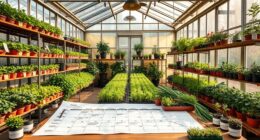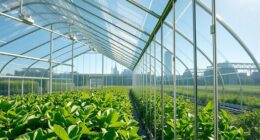Composting inside your greenhouse offers many advantages, like reducing the need for synthetic fertilizers and improving soil health by adding vital nutrients. It also encourages beneficial microorganisms and can improve plant growth. However, you'll face challenges such as managing contaminants and varying waste quality. Maintaining proper conditions is crucial to avoid odors and produce high-quality compost. If you're interested in leveraging these benefits while navigating potential pitfalls, there's more to explore about the best practices for your greenhouse composting journey.
Key Takeaways
- Composting in a greenhouse reduces reliance on synthetic fertilizers, enhancing soil health and promoting sustainable plant growth.
- It creates a stable environment that fosters beneficial microorganisms, improving soil activity and plant resilience.
- Challenges include contamination from non-compostable materials and the need for consistent feedstock quality.
- Proper management, such as maintaining moisture and aeration, is crucial to prevent odors and produce high-quality compost.
- Composting helps mitigate greenhouse gas emissions by diverting organic waste from landfills and enriching soil.
Definition and Purpose of Greenhouse Composting
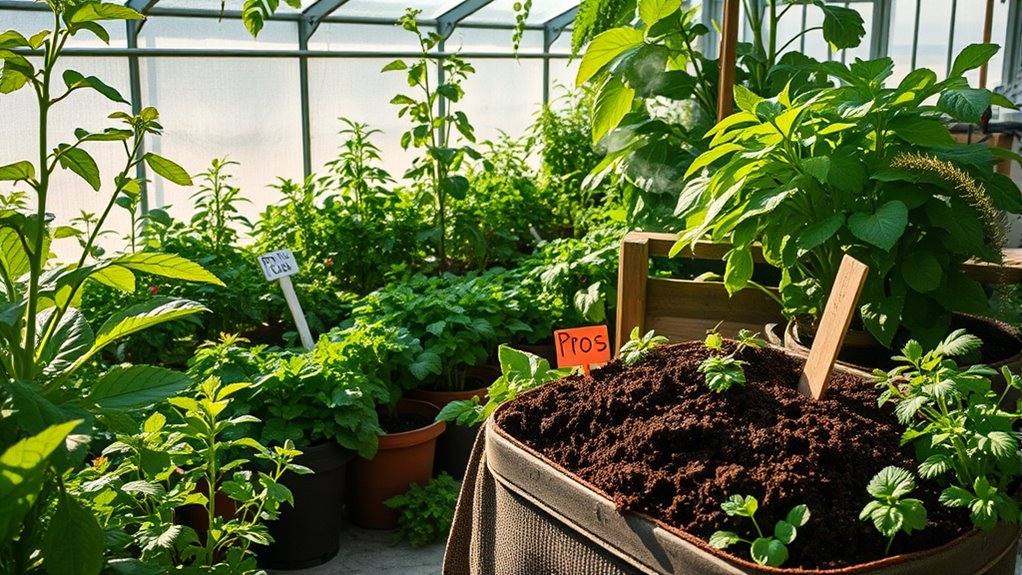
When you consider greenhouse composting, you're looking at a sustainable way to decompose organic materials right inside your greenhouse, ultimately transforming waste into nutrient-rich soil amendments.
Greenhouse composting transforms organic waste into nutrient-rich soil amendments, promoting sustainability and enhancing plant growth.
This method serves a dual purpose: managing waste effectively while enhancing plant growth and soil health. By composting within your greenhouse, you can produce nutrients year-round and maintain optimal temperatures for your plants. The process relies on aerobic decomposition, needing oxygen, carbon, nitrogen, and microorganisms to break down materials efficiently. The compost you create will improve soil fertility, structure, and water retention, supporting robust plant development. Additionally, composting reduces reliance on chemical fertilizers, promoting healthier plant growth.
Embracing greenhouse composting not only enriches your garden but also contributes to a more sustainable environmental future.
Materials Suitable for Composting in a Greenhouse

To create a successful compost pile in your greenhouse, it's essential to choose the right materials that will promote efficient decomposition.
Start with carbon-rich materials like dry leaves, twigs, and cardboard, which help absorb excess moisture and add structure to your pile. Pair these with nitrogen-rich options such as fresh grass clippings, kitchen scraps, and coffee grounds to support microbial growth. Composting is vital for sustainable agriculture, as it converts food scraps and other organic materials into fertilizer while preventing valuable materials from entering landfills, where decomposition is slower.
You can also include livestock manure for extra nutrients and heat. Don't forget greenhouse-specific materials like plant trimmings and weeds.
However, avoid meat, dairy, oils, and treated wood to keep pests at bay. By mixing a diverse range of materials, you'll maintain a balanced carbon-to-nitrogen ratio for optimal composting.
The Composting Process: Aerobic vs. Anaerobic

Understanding the differences between aerobic and anaerobic composting is crucial for maximizing efficiency in your greenhouse.
Aerobic composting relies on oxygen to decompose organic materials quickly, generating heat and producing less harmful carbon dioxide. Using aerated systems ensures proper oxygen flow, leading to effective decomposition and pathogen control. Additionally, aerobic composting produces less harmful greenhouse gases, making it a more environmentally friendly option.
In contrast, anaerobic composting occurs without oxygen, resulting in slower breakdown and the release of methane, a potent greenhouse gas. While anaerobic processes can produce biogas, they often allow pathogens and weed seeds to survive.
For your greenhouse, aerobic composting is typically more beneficial due to its speed, reduced odor, and lesser environmental impact, making it the preferable choice for healthy compost production.
Benefits of Composting for Soil Health
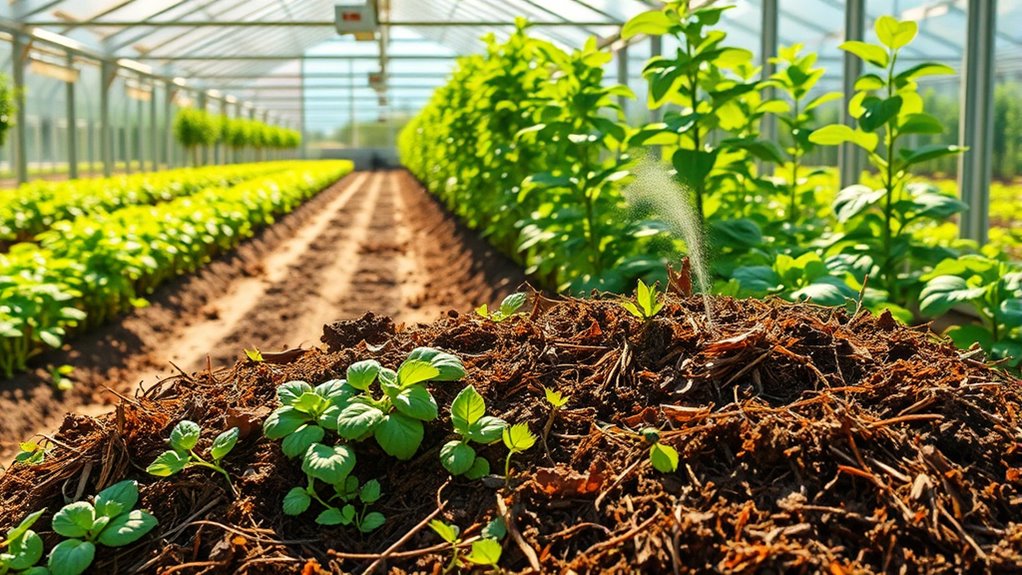
Composting offers a wealth of benefits that significantly enhance soil health in your greenhouse. It improves soil structure by increasing porosity, reducing erosion, and promoting stable aggregates. This allows better water infiltration and retention, which means your plants can access more moisture. Enhanced aeration helps roots grow and soil organisms thrive. Nutritionally, compost provides essential slow-release nutrients, increases cation exchange capacity, and reduces your reliance on synthetic fertilizers. With compost, beneficial microbes flourish, breaking down toxic compounds and supporting plant health. Additionally, it stabilizes soil pH and improves fertility, creating a thriving ecosystem. Overall, composting makes your soil more resilient and productive, fostering healthier plants and a more sustainable greenhouse environment. Composting is seen as a solution to improve food quality and soil health, especially in light of conventional agriculture's nutrient loss.
Environmental Impact of Composting Practices
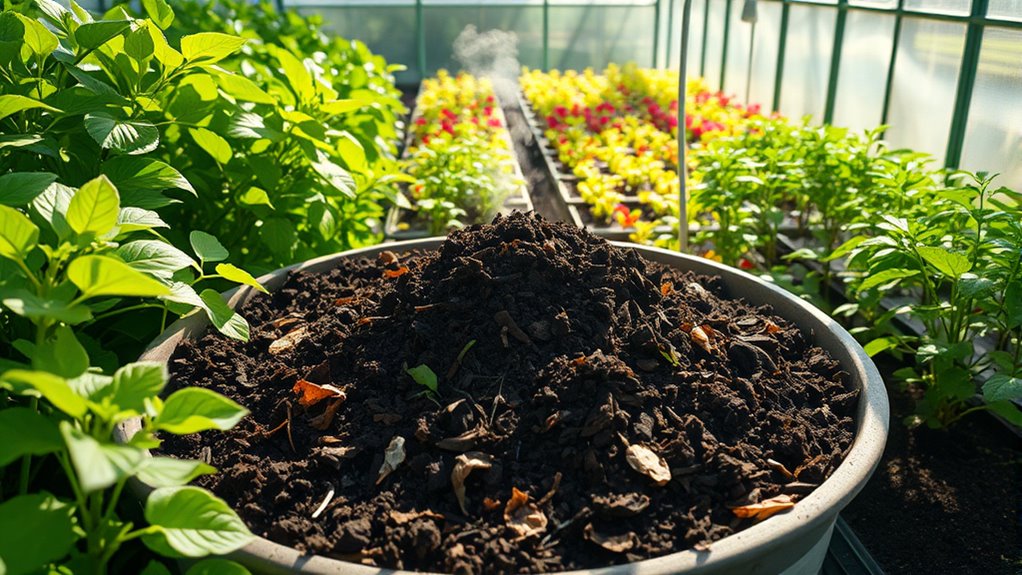
Composting helps you reduce greenhouse gas emissions by keeping organic waste out of landfills, where it would produce methane—a gas with a global warming potential 36 times greater than CO2. By composting, you can mitigate up to 50% of these emissions. Additionally, composting reduces air pollution from incineration, protecting both your health and the community's. Furthermore, practicing the art of decluttering in your composting process can enhance your overall gardening experience, as it promotes mindfulness and efficiency. Plus, composting diverts a large portion of municipal waste, effectively lowering landfill contributions.
This not only preserves groundwater but also enriches soil, making it easier to grow healthy plants without relying on synthetic fertilizers.
Your composting efforts truly matter!
Heating and Temperature Control in a Greenhouse

To maintain a thriving greenhouse environment, effective heating and temperature control are essential for plant health and productivity.
You can choose from various heating methods to suit your needs. Passive solar heating maximizes sunlight, while solar heating uses photovoltaic panels for efficiency. Geothermal heating offers free heat through underground tubes, though it requires installation. For quick warmth, forced air heating with electric coils works well. Compost heating can also provide warmth but may have variable temperatures. Geothermal heating can also help regulate the temperature during warmer months by drawing cold air from the earth. Additionally, utilizing heat pumps can significantly enhance the energy efficiency of your greenhouse heating system.
Incorporating thermal mass materials stabilizes temperature, alongside proper insulation to retain heat.
Ventilation systems prevent overheating and maintain air circulation. Monitoring systems like thermometers help you track fluctuations, ensuring your plants thrive in optimal conditions.
Soil Improvement and Fertilization Advantages
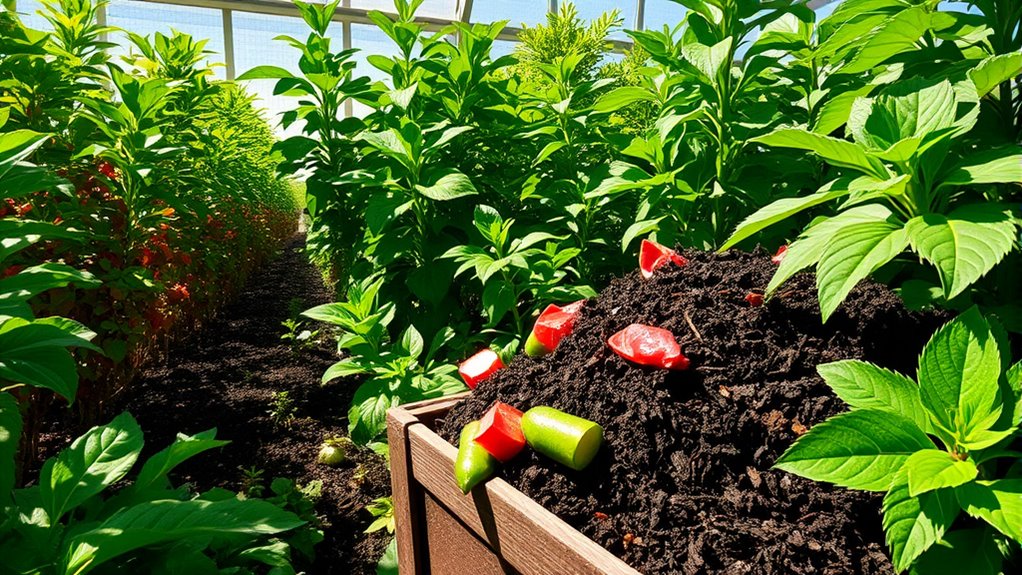
Maintaining optimal temperature in your greenhouse sets the stage for healthy plant growth, but it's not just about heat; soil quality plays a significant role too.
By adding compost, you enhance soil structure, improving porosity and drainage, which helps roots grow effectively. This improves water retention, reduces erosion, and even binds heavy metals, boosting overall soil health. Additionally, compost-amended soils enable effective carbon storage, contributing to the sustainability of your greenhouse ecosystem.
Compost acts as a natural fertilizer, providing essential nutrients slowly to support healthy plant growth while reducing your reliance on synthetic options.
Additionally, it introduces beneficial microorganisms that enhance soil activity, suppress harmful pathogens, and improve resilience.
With compost, you create a stable environment that fosters biodiversity and enriches your greenhouse, ensuring your plants thrive for years to come.
Challenges and Limitations of Greenhouse Composting
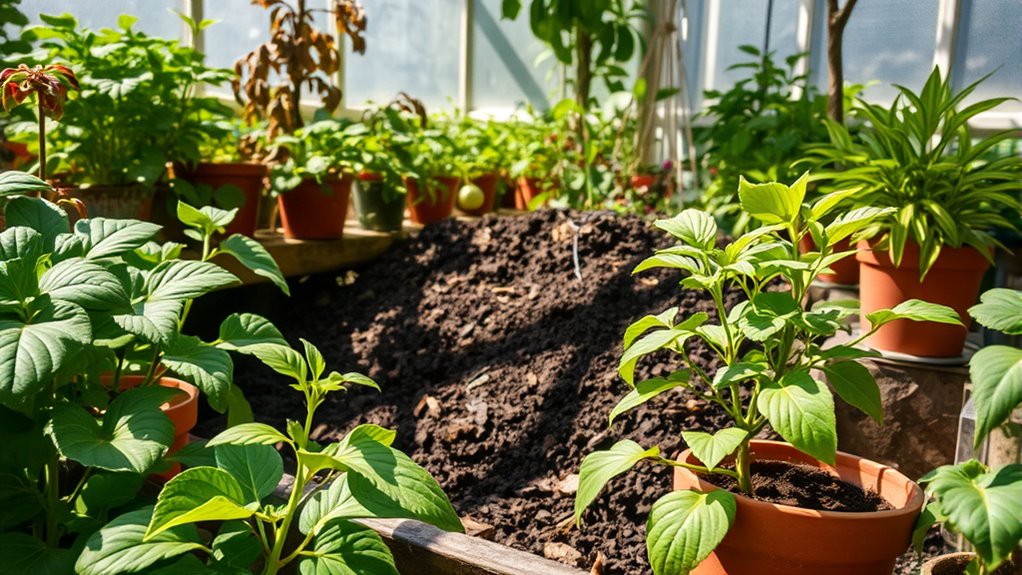
Composting in your greenhouse can be a rewarding practice, but it comes with its own set of challenges and limitations.
You'll face issues with contamination, as non-compostable materials like plastics can degrade compost quality and harm ecosystems. Sorting these contaminants can be time-consuming and labor-intensive.
Additionally, inconsistent feedstock can complicate your efforts; varying waste quality affects composting efficiency. You might struggle to maintain the right carbon-to-nitrogen ratio, and excessive nitrogen can lead to unpleasant odors. Contamination ultimately results in low-quality compost, which can undermine your gardening efforts.
Moreover, public awareness and participation can limit your composting success, particularly if your community lacks resources. Navigating regulatory hurdles and ensuring compliance with environmental standards can also be daunting, making greenhouse composting a complex endeavor.
Best Practices for Successful Composting in a Greenhouse

Successful composting in a greenhouse hinges on a few best practices that can significantly enhance your results.
Start by choosing the right method; aerobic or hot composting works best for efficient heat generation. Layer your materials strategically, mixing brown and green materials in a balanced ratio to promote decomposition and achieve an optimal carbon-to-nitrogen ratio.
Ensure your compost pile has proper moisture—like a wrung-out sponge—and monitor the temperature regularly to maintain optimal conditions. Creating an eco-friendly and energy-efficient environment can be achieved by placing your composting system within the greenhouse, which captures heat and CO2. Use bins or piles that allow for aeration, and turn your compost frequently to enhance oxygen flow.
Finally, keep an eye on odors; if they arise, adjust your mix. By following these practices, you'll create nutrient-rich compost that benefits your greenhouse operations and plant growth.
Frequently Asked Questions
How Long Does It Take for Compost to Mature in a Greenhouse?
It usually takes compost anywhere from one month to over a year to mature in a greenhouse.
The time depends on factors like the size of the materials you're using and how well you manage the pile. Regularly turning the compost helps aerate it, speeding up the process.
Keep an eye on moisture levels and the carbon-to-nitrogen ratio, as these are crucial for efficient decomposition and faster maturation.
Can I Compost Meat and Dairy Products in My Greenhouse?
Imagine your greenhouse as a vibrant ecosystem, where every element contributes to growth.
You can compost meat and dairy, but proceed with caution. These organic materials can attract pests and harbor pathogens, disrupting harmony.
Hot composting or specialized systems can help manage risks while enriching your soil. If you're ready to embrace the challenge, ensure proper temperature control and odor management to maintain your greenhouse's health and balance.
What Tools Are Necessary for Effective Greenhouse Composting?
To effectively compost in your greenhouse, you'll need some essential tools.
Start with compost bins to manage your materials. Equip yourself with shovels and pitchforks for turning piles and aerating them. A compost sifter helps separate finished compost from larger bits.
Don't forget moisture control systems to maintain optimal levels and thermometers to monitor temperatures.
Each tool enhances your composting efficiency, ensuring you create nutrient-rich soil for your plants.
How Do I Prevent Pests in My Compost Pile?
To prevent pests in your compost pile, maintain a proper balance of browns and greens, aiming for a 3:1 ratio.
Keep the pile moist but not soggy, and regularly turn it to promote aeration.
Avoid adding meat or dairy, which attract pests.
Cover the pile with a lid or tarp to limit air circulation and deter pests.
Finally, regularly inspect the pile for signs of infestation and adjust your practices as needed.
Is Composting Safe for Indoor Greenhouse Environments?
Composting can be safe in indoor greenhouse environments if you follow proper practices.
You'll want to maintain a balanced carbon-to-nitrogen ratio and ensure good aeration to prevent odors and pests.
Keep moisture levels in check to avoid anaerobic conditions.
Be cautious with materials—steer clear of anything that might harbor pathogens.
Regular monitoring and maintenance will help you create a safe, productive composting system that benefits your greenhouse's ecosystem.
Conclusion
Composting inside your greenhouse isn't just a smart move; it's like giving your plants a five-star spa treatment! By turning kitchen scraps and garden waste into nutrient-rich compost, you're boosting soil health and reducing waste. While there are challenges, the benefits far outweigh them. Embrace this eco-friendly practice, and you'll not only enhance your greenhouse's productivity but also contribute positively to the environment. So gear up, and let your composting journey flourish!







